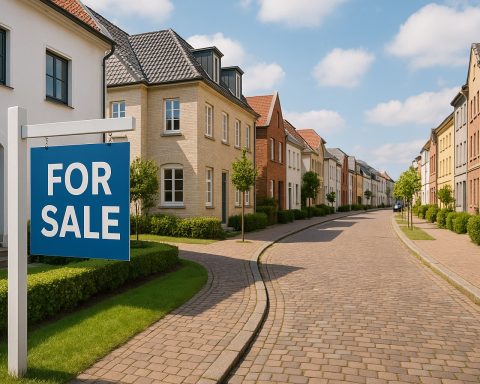Introduction: A Soaring Market in 2025
Lisbon’s real estate market is red-hot in 2025, with property values surging to record highs and demand from both locals and international buyers at a fever pitch. Despite global economic headwinds, Portugal’s capital has become one of Europe’s most dynamic property hotspots. Home prices nationally jumped 15.8% year-on-year as of March 2025, outpacing growth in the EU and US portugalpathways.io. In Lisbon, housing supply struggles to keep up with foreign investment pouring into property (over €3.5 billion in the last year) portugalpathways.io and an influx of expats (the foreign resident population has surged, with US nationals up 340% in five years portugalpathways.io). The result is a market where prices keep climbing and competition for quality real estate is intense. This report provides a comprehensive deep-dive into Lisbon’s residential and commercial property sectors, examining market trends, pricing, rental yields, supply-demand dynamics, key neighborhoods, and the macroeconomic and regulatory backdrop. It also highlights investment opportunities versus risks and distills expert forecasts for the years ahead.
(All monetary figures are in Euros. Data is current as of 2025. Citations refer to sources for verification.)
Residential Real Estate Market in Lisbon (2025)
Price Trends and Housing Market Performance
Lisbon’s housing prices have been on a decade-long tear, more than doubling since 2015 theportugalnews.com. After a brief cooling in 2020–2021, the growth has resumed vigorously. Citywide average asking prices now hover around €6,424 per square meter (as of Jan 2025) tagusproperty.com. That city average rose roughly 5% in 2024 tagusproperty.com, a more moderate gain compared to Portugal’s nationwide 12%+ surge reddit.com, but still significant given how high Lisbon’s base prices already are. Table 1 shows a snapshot of prices in select Lisbon districts:
Table 1: Lisbon Residential Property Prices by District (2025) (average asking price and annual change) tagusproperty.com tagusproperty.com
| District (Area) | Avg Price €/m² | 2024 Price Change |
|---|---|---|
| Santo António (Central luxury) | €8,275 | +2.5% tagusproperty.com |
| Avenidas Novas (Modern center) | €7,436 | +6.1% tagusproperty.com |
| Estrela (Prime residential) | €7,406 | +5.9% tagusproperty.com |
| Marvila (Emerging east side) | €5,687 | +23.2% tagusproperty.com |
| Lumiar (Northern Lisbon) | €5,356 | +15.7% tagusproperty.com |
| Lisbon City Average | €6,425 | +5.1% tagusproperty.com |
Source: Idealista.pt data (Jan 2025), via Tagus Property. Santo António includes Avenida da Liberdade; Marvila and Lumiar are high-growth districts.
As shown above, central upscale neighborhoods like Santo António (which covers Avenida da Liberdade) command the highest prices – often €7,000–€8,000+ per m² – whereas historically working-class areas under regeneration, such as Marvila in the city’s east end, are cheaper but saw explosive growth (+23% in 2024) tagusproperty.com. Overall, Lisbon’s average price (~€6.4k/m²) is now on par with other Western European capitals’ peripheral areas, yet still lower than prime London or Paris, indicating room for further appreciation. Indeed, a Knight Frank forecast ranks Lisbon among Europe’s top cities for luxury price growth in 2025, projecting +4.5% for high-end homes saadahsan.com, and a conservative scenario sees Portugal’s overall house prices rising around 5–6% in 2025 while many EU markets stagnate saadahsan.com.
Several factors underpin Lisbon’s price resilience. Buyer demand remains robust, bolstered by a stable economy and returning confidence as interest rates begin to edge down. Mortgage rates in Portugal averaged 3.39% in early 2025, slightly lower than a year prior as the European Central Bank signals rate cuts reddit.com reddit.com. This, coupled with new government mortgage incentives for first-time buyers, has improved affordability marginally theportugalnews.com theportugalnews.com. However, housing supply is painfully tight – only about 28,000 new housing units were licensed nationwide in 2024, far below what’s needed theportugalnews.com. Construction faces structural challenges like labor shortages (90,000 workers needed) and bureaucratic delays, which drive up costs and limit new development theportugalnews.com theportugalnews.com. Thus, even with economic tailwinds, the fundamental mismatch between demand and supply continues to push prices upward. Analysts note that without rapid increases in construction, these dynamics will keep upward pressure on prices through 2026 theportugalnews.com theportugalnews.com.
Rental Market and Yields
Lisbon’s rental market is tight and pricey, fueled by the same supply-demand imbalance. Rents have risen sharply post-pandemic: for instance, advertised house rents jumped 8.1% in 2023 alone amid a housing shortage investropa.com. A two-bedroom apartment in a central district can easily command a few thousand euros per month if modern or renovated. Rental yields (gross) typically range from ~3% up to 6% depending on property type and location tagusproperty.com. Core neighborhoods yield on the lower end (~3–4%) due to high prices, whereas smaller apartments in emerging areas or student rentals can see 5–6%. The average gross yield in Portugal is around 5% in 2025, slightly down from the prior year as price growth outpaced rent growth reddit.com reddit.com. Still, a ~5% yield is attractive compared to many Western European cities, especially given Portugal’s relatively low property taxes.
One quirk of Lisbon’s rental scene is the legacy of past rent control laws. For decades, old tenancy laws capped rents at token levels, discouraging landlords from renting at all – many preferred to leave units vacant rather than locked into unprofitable leases tagusproperty.com. Reforms (the Nova Lei do Arrendamento Urbano) eventually liberalized rents, gradually releasing more supply onto the market tagusproperty.com. Even so, rental supply remains constrained and often of average quality tagusproperty.com. A landlord-friendly reminder: if buying a tenanted property, ensure the lease is recent – older leases may still be under old rules with very low controlled rents, slashing any yield potential tagusproperty.com.
Short-term rentals (Airbnb-style) add another layer. Pre-2020, many investors flocked to buy Lisbon apartments for lucrative tourist rentals. This contributed to supply shortages for locals. In response, authorities have recently restricted new short-term rental licenses in Lisbon’s central areas as part of a housing affordability push (the 2023 “Mais Habitação” package). While existing licensed Airbnbs can continue, the era of easy conversion of homes to vacation rentals is ending. Investors now pivot more to medium-term or long-term rentals, or look to other areas for short-term rental opportunities. The regulatory climate is thus shifting toward protecting tenants and boosting long-term supply – a factor that new investors must weigh in their rental strategies.
Demand and Supply Dynamics
Demand in Lisbon’s residential sector is a tale of two forces: strong local household formation and extraordinarily high international interest. On the local side, Portugal’s economy has stabilized from the pandemic and continues to grow (~2–3% GDP growth) portugalpathways.io, unemployment is low (~6%) luminyst.estate, and wages have inched up – giving more Portuguese families confidence to buy, even as they grapple with high prices. The government has sweetened the deal for young and first-time buyers with tax breaks and low-interest loans theportugalnews.com, stimulating additional demand in 2024–25. At the same time, net migration into Portugal topped 155,000 people in 2023 theportugalnews.com – a huge influx for a small country – reflecting how popular Portugal has become for expats, digital nomads, retirees, and returning emigrants. Lisbon, as the capital, absorbs a large share of these newcomers, whether they are Brazilian families, French remote workers, or American tech professionals. These groups often come with greater buying power or foreign income, heightening competition for properties.
On the supply side, however, Lisbon faces chronic undersupply. New construction is limited by land constraints (Lisbon is a compact, built-up city), lengthy permitting processes, and construction sector bottlenecks. Even with developer interest high, projects take time. To illustrate, a major redevelopment project in eastern Lisbon’s Marvila/Matinha area – reclaiming old industrial land – will add 2,000 new homes plus parks and a school, but over multiple phases extending beyond 2026 theportugalnews.com theportugalnews.com. Citywide, pipeline estimates suggest a few thousand units in progress, which is nowhere near enough to satisfy demand. In 2024, only 25,000–30,000 housing permits were issued in the entire country theportugalnews.com. This lag has created what analysts call a structural housing deficit. Even as the government earmarked €2.8 billion in the 2025 budget to build 59,000 affordable homes by 2030 investropa.com, these efforts will take years to bear fruit theportugalnews.com. In the meantime, competition for existing homes is fierce, and bidding wars or quick sales for desirable listings are common in Lisbon. It is truly a seller’s market in most segments.
Who is buying? Foreign buyers and investors account for a substantial chunk of transactions by value. In 2024, an estimated €2.5 billion of real estate investment in Portugal came from foreign capital theportugalnews.com. High-net-worth individuals from the US, UK, Brazil, France, China and beyond continue to target Lisbon for its relatively affordable prices (by global city standards), sunny lifestyle, and safety. Foreigners made up 81% of all real estate investment volume in Portugal last year (including commercial deals) portugalpathways.io. Expats relocating for work or quality of life also buy homes: as of end 2023, around 12% of Portugal’s population are foreign residents portugalpathways.io. This international demand not only props up the market but also changes its character – luxury renovation projects and new condo developments cater to foreign tastes, and some local buyers feel squeezed out. The Portuguese government in 2023 responded by ending the Golden Visa program’s property purchase option (no longer can non-EU citizens obtain residency by simply buying Lisbon real estate) portugalpathways.io. This removal, effective October 2023, aimed to cool speculative foreign demand. However, its impact on Lisbon’s prime segment appears limited so far – demand was already diversified, and those seeking Golden Visas have shifted to investing via qualifying funds instead portugalpathways.io portugalinvestmentownersclub.com. In short, demand remains far in excess of supply, and until that changes, Lisbon’s housing market is likely to stay on its upward trajectory.
Key Neighborhoods and Notable Developments
Lisbon is a city of diverse neighborhoods, each with unique appeal in the property market. Here are some key areas and trends to watch:
- Historic & Luxury Core (Chiado, Avenida da Liberdade, Principe Real, Lapa/Estrela): These central zones form Lisbon’s most prestigious addresses. Elegant 19th-century buildings, luxury boutiques, and embassy mansions define them. Prices here are the highest in the city – new or fully renovated apartments often range €9,000–€12,000 per m² tagusproperty.com. For example, Avenida da Liberdade (in Santo António parish) and Chiado routinely see top-of-market pricing (up to €10–12k/m² for new luxury projects) tagusproperty.com tagusproperty.com. Growth is slower in these areas (+2–5%/year) simply because they’re already priced at a premium tagusproperty.com. Rental yields here tend to be lowest (~3%) as purchase prices are steep. Still, demand remains very strong from affluent international buyers who prize central location and charm. Inventory is scarce (many buildings are heritage-protected), so developers focus on rehabbing historic buildings into modern luxury condos – often preserving facades and adding contemporary interiors tagusproperty.com.
- Emerging East: Marvila & Beato (Riverside Redevelopment): Once gritty industrial districts, Marvila and neighboring Beato (east Lisbon) have become the hotspots for new development. Large parcels of formerly derelict waterfront land are being transformed into modern residential communities. A flagship project is Prata Riverside Village, a Renzo Piano-designed mixed-use development delivering 830 new apartments plus parks and retail by 2026 theportugalnews.com. Adjacent to that, the huge “Fábrica da Matinha” regeneration will bring ~2,000 homes and 120,000 m² of green and commercial space over the next few years theportugalnews.com theportugalnews.com. These projects aim to reconnect Lisbon with its Tagus River waterfront and create new 15-minute city neighborhoods. Anticipation of this revitalization has already sent prices soaring in Marvila (+23% in 2024, highest growth in Lisbon) tagusproperty.com. Even after that jump, at ~€5,500–€6,000/m² Marvila’s values are still below city average, making it attractive for investors banking on future appreciation. Beato, similarly, is on the map with planned creative hubs and co-working campuses, though its 2024 prices dipped slightly (–2%) as it’s early in the gentrification curve tagusproperty.com. Look for East Lisbon to continue rising as new inventory and amenities come online; it offers a compelling mix of waterfront living, trendy repurposed warehouses (brewpubs, art galleries), and proximity to the city center.
- Modern Center & Family Districts (Avenidas Novas, Alvalade, Benfica, Lumiar): Outside the tourist-heavy historic core, Lisbon’s “New Avenues” (Avenidas Novas) and nearby Alvalade are leafy, middle-upper class areas known for 20th-century buildings and good infrastructure. They have seen solid price growth (~+5–6% in 2024) and values around €6,000–7,500/m² tagusproperty.com tagusproperty.com. These areas attract well-off local families and expats who want more space, parking, and parks while still being central. North of these, districts like Benfica, Lumiar, and Telheiras offer more affordable suburban-style living (prices ~€4,500–5,500/m²) and have surged in popularity as alternatives – Lumiar jumped +15.7% in 2024 tagusproperty.com, partly due to new-build condos and improved metro connections. Campo de Ourique and Campolide (near central Lisbon) are also worth noting: these have a village-like vibe with strong local commerce and have experienced price rises in the mid-single digits, keeping them around €6,500/m² tagusproperty.com. For investors looking at rental income, these non-touristy residential zones can offer stable long-term tenants (families, students) and slightly better yields than the ultra-prime areas.
- Coastal & Suburban Hotspots (Cascais, Oeiras, Sintra): The Lisbon metropolitan area extends well beyond city limits, and many foreign buyers end up in the scenic suburbs. The resort town of Cascais/Estoril, about 30 km west along the coast, remains one of Portugal’s priciest markets (luxury villas easily top €8,000–10,000/m² tagusproperty.com). It’s nicknamed the “Portuguese Riviera” and draws wealthy expats seeking oceanfront living, golf, and international schools. Oeiras, closer to Lisbon, is emerging as a tech hub (home to several business parks) and offers upscale condos with ocean views at relatively lower prices than Cascais (around €4,500/m² for high-end) tagusproperty.com. Meanwhile, Sintra, with its stunning hills and palaces, offers large estates and quirky historic homes – a different segment but increasingly on foreigners’ radar. Back within the city, areas like Parque das Nações (the Expo 98 new town) illustrate how supply influx can temper prices: Parque das Nações saw a price decline of 8% in 2024 tagusproperty.com as a lot of new apartments hit the market and some older units became less competitive. It remains a desirable, modern area (family-friendly, riverfront), but this shows that even in Lisbon, oversupply in a micro-market can soften prices. Investors should thus watch which neighborhoods have significant new development vs. which have almost none – the latter are likely to see prices hold firm or rise.
In summary, Lisbon’s neighborhoods each tell a part of the story: a mix of ultra-expensive historic districts with limited stock, rejuvenated industrial zones adding much-needed housing, established residential areas steadily climbing, and a spillover of demand into the metro region’s coastal and commuter towns. This diversified landscape gives investors and homebuyers options from luxury penthouses to value-add fixer-uppers, depending on their strategy.
Commercial Real Estate Market in Lisbon (2025)
While residential headlines often steal the spotlight, Lisbon’s commercial property sectors – offices, retail, hospitality, and logistics – are also thriving in 2025, buoyed by economic growth and investor interest. International institutional investors have Portugal on their radar, given the country’s strong post-Covid recovery and attractive yields relative to Western Europe. In fact, real estate investment volumes in Portugal are forecast to reach €2.5 billion in 2025 (up ~8% year-on-year), marking a continued upward trajectory cbre.pt. Lisbon, as the capital, attracts the bulk of those euros, especially in offices, retail, and hotels. Below we break down the key commercial sectors:
Office Sector: High Demand, Low Vacancy, Rising Rents
Lisbon’s office market is experiencing a boom in occupancy and development. After a pandemic-era lull, leasing activity roared back – the city saw 193,000 m² of office space taken up from Jan–Nov 2024, one of the highest levels on record (second only to the 2022 peak) essential-business.pt essential-business.pt. To put that in perspective, take-up was 120% higher than the same period in 2023 essential-business.pt, reflecting a return of business expansion and pent-up demand. Driving this absorption are several factors: multinational companies (especially in tech, finance, and call centers) are setting up or expanding Lisbon hubs, and some operations that might have gone to London or Eastern Europe have relocated to Portugal due to Brexit and the Ukraine war (Lisbon seen as a stable, cost-effective alternative) essential-business.pt. Notably, large global firms are drawn by Portugal’s “cheap talent” and lower costs – Lisbon’s prime office rents (~€25–30/m²/month) are a bargain next to Paris (€80) or even Madrid (€37) essential-business.pt. This cost gap, combined with a highly educated workforce and sunny lifestyle, has led observers to quip that “Portugal is the India of Europe” for back-office operations essential-business.pt.
Vacancy rates in Lisbon offices are very low – around 7–8% on average essential-business.pt (and <5% in prime CBD zones traverseinternationalfinance.com). Essentially, quality office space is scarce. Many older office buildings are outdated, and only a few new builds have come online in recent years. Companies hunting for large, modern floor plates often have limited choices, leading some to pre-lease space in projects under construction. Savills reports over 20 new office projects (total ~245,000 m²) are in the pipeline through 2026, yet over 40% of that future space is already pre-let, highlighting the supply crunch essential-business.pt. Key submarkets include the Parque das Nações area, which alone accounted for 36% of Lisbon’s office take-up in 2024 (thanks to big leases in new buildings) essential-business.pt, and the “New Office Zone” (likely western corridors like Miraflores or Carnaxide) with 23%. The traditional CBD (downtown core) represented about 15% of volume essential-business.pt. Financial services firms led leasing activity (29% of space taken), followed by TMT – tech, media, telecom – at 18% essential-business.pt.
This tight market means landlords have the upper hand. Prime office rents are rising and now approach €28–30 per m²/month in central Lisbon for top Grade A spaces traverseinternationalfinance.com. Secondary locations achieve lower rents (high-teens to low-20s €/m²), but those too are edging up due to spillover demand. Even with these increases, Lisbon’s office rents remain highly competitive internationally, which continues to lure occupiers. For investors, prime office yields are attractive, roughly 5.0% in Lisbon in 2025 traverseinternationalfinance.com. By comparison, yields in other capitals have compressed below 4% in many cases, so Portugal offers a yield premium. This has not gone unnoticed – several international funds and REITs have acquired Lisbon office assets, betting on rental growth. The combination of low vacancy (~7%) and anticipated rent hikes bodes well for continued performance essential-business.pt. As one market expert summarized, Lisbon has emerged as one of Europe’s most competitive office markets, with strong fundamentals and new, high-standard projects finally coming to relieve the pent-up demand essential-business.pt essential-business.pt. The outlook for 2025 is positive: expect further large lease deals (some tenants are pre-committing to space completing in 2025–26), and if economic conditions hold, office investment volume should stay robust.
Retail & Hospitality: Riding the Tourism Wave
Lisbon’s retail property sector has proven resilient, adapting to changing consumer habits and a tourism boom. High-street retail in prime areas – e.g. Baixa/Chiado downtown and Avenida da Liberdade – is thriving thanks to record tourist footfall and the city’s growing affluent class traverseinternationalfinance.com traverseinternationalfinance.com. Strolling down Chiado, one sees international luxury brands and local boutiques buzzing with shoppers. Rents for prime storefronts have been climbing and occupancy is near 100% on key stretches. In fact, a lack of available shop units was noted in 2024 cbre.pt. The good news for retailers is that new retail stock is under construction and expected to hit the market in 2025, which may finally provide some relief and allow new brands in cbre.pt. Retail yields are generally in the 5–6% range for prime high street properties, although exact figures vary. Shopping centers in Lisbon also recovered well after COVID-19, especially those that pivot to experience-based offerings. Malls are adding more entertainment, dining, and leisure components to stay relevant traverseinternationalfinance.com. One notable trend is the popularity of retail parks and big-box stores on city outskirts – open-air formats with anchors like IKEA, Continente (grocery), etc., which remain solid performers even as e-commerce grows traverseinternationalfinance.com traverseinternationalfinance.com.
The hospitality sector in Lisbon is a standout performer. Portugal had a tourism record year in 2023–24, and Lisbon – repeatedly crowned among Europe’s top travel destinations – benefited enormously. Hotel occupancy and daily rates in the city hit all-time highs in 2024 (in popular months, occupancy often exceeded 80–90%). This has translated into investor appetite: hotels have been one of the most targeted asset classes for the third year running cbre.pt, with several high-profile transactions and new hotel projects launching. The outlook for 2025 remains strong, as Lisbon’s appeal shows no sign of waning. Industry experts expect another year of robust hotel performance, unless unforeseen global events intervene cbre.pt. The pipeline includes both luxury hotels (international brands entering or expanding in Lisbon) and boutique offerings, often by renovating charming historic buildings. Additionally, the rise of remote work-friendly extended stay hotels and co-living spaces is blurring the line between residential and hospitality, providing new investment niches.
Tourism’s boom also feeds the food & beverage (F&B) retail segment – cafes, bars, restaurants are flourishing in tourist zones and trendy neighborhoods alike. This in turn supports retail real estate: investors have shown interest in acquiring prime restaurant/bar spaces (for example, along the waterfront or nightlife districts) knowing the tenant demand is strong. One risk to monitor is that an overreliance on tourism can make retail rents volatile in downturns. But as of 2025, Lisbon enjoys a sweet spot of both local consumer spending (helped by wage growth and job security) and tourist spending, keeping tills ringing.
Industrial & Logistics: Nearshoring Boost and Low Availability
Though smaller in scale than other sectors, logistics and industrial real estate around Lisbon is experiencing a surge in demand. The e-commerce wave and a push for supply chain resilience have put a spotlight on warehouse space, which was traditionally underdeveloped in Portugal. Big-box logistics facilities near Lisbon’s outskirts (such as Azambuja and Montijo/Setúbal corridors) are now highly sought after traverseinternationalfinance.com traverseinternationalfinance.com. Vacancy in modern warehouses is extremely low (<5% in prime parks) and rents have been rising accordingly. Nearshoring – companies moving manufacturing or distribution closer to Western Europe – also plays a role, with Portugal grabbing some investments in light industry and assembly operations cbre.pt. The country’s strategic location and good infrastructure (Lisbon and Sines ports, road network) make it a logical logistics hub for Iberia. However, the supply of Grade A logistics parks is limited; developers are now catching on, and new projects are in the pipeline on Lisbon’s periphery.
Current prime logistics rents in Lisbon area are roughly €5–6/m²/month, having trended up due to scarcity. Yields for logistics have compressed globally, but in Portugal they remain around 6-7%, offering a premium over other asset classes. Investors like the stable long-term leases that logistics often provides (with major retailers or 3PLs as tenants). One challenge is land availability and zoning – to build modern 50,000 m² warehouses, you need large land parcels, which are finite near Lisbon. The government has been encouraging industrial investment and may streamline some planning to facilitate more development. In short, while the logistics sector is a relatively small piece of Lisbon’s real estate market today, it’s one of the fastest-growing segments and an area to watch for expansion and opportunity in coming years.
Macroeconomic and Regulatory Factors Influencing the Market
Multiple macroeconomic and policy factors shape Lisbon’s real estate trajectory. On the economic front, Portugal currently enjoys a favorable backdrop: growth is steady, inflation is under control, and borrowing costs, while higher than the ultra-low rates of early 2020s, are expected to fall gradually through 2025–2026. Let’s break down the key factors:
- Economic Growth and Stability: Portugal’s economy rebounded strongly from the pandemic. While GDP growth cooled from 6.8% in 2022 to about 2.3% in 2023 reddit.com, it remains robust compared to many EU peers. Forecasts project ~2.4% GDP growth in 2025, outpacing the Eurozone average (~0.8%) portugalpathways.io. A growing economy boosts consumer confidence, employment, and income – all supporting housing demand. Lisbon, as the capital, benefits from increased business activity and foreign investment (Portugal attracted €13.2 billion in FDI in the last 12 months, up 19% year-on-year portugalpathways.io, a portion of which feeds into real estate and infrastructure). Unemployment is low (~6%) luminyst.estate and Portugal’s quality-of-life remains a magnet for talent and retirees. These factors mean the fundamental demand drivers for property (household formation, corporate expansion) are on solid footing.
- Interest Rates and Credit Conditions: The interest rate environment has a huge impact on real estate. After aggressive rate hikes in 2022–23 by the European Central Bank to combat inflation, 2024 saw rates plateau and hints of reversal. The ECB’s deposit rate peaked around 4% and there’s indication of easing into 2025. Portuguese banks’ mortgage rates have correspondingly stabilized and even edged down from their highs reddit.com luminyst.estate. At around 3.4%, the average mortgage rate is still higher than the ~1% loans of early 2020s, but the trajectory is now downward luminyst.estate. The government introduced credit incentives (like interest rate subsidies for young buyers and a program to convert variable-rate loans to fixed) to alleviate the shock of higher rates reddit.com. So financing, while tighter than before, is gradually improving – which unlocks more buyers. On the commercial side, higher rates did push some global investors to the sidelines in 2023; however, as rate expectations improve and Portugal offers higher yields relative to Western Europe, investment is flowing back. Liquidity in the lending market remains adequate, with both local banks and international lenders (including debt funds) willing to finance viable real estate projects at moderate LTVs (~60%) traverseinternationalfinance.com.
- Inflation and Construction Costs: Inflation in Portugal has come back down to around 2.5% as of late 2024 luminyst.estate, after peaking earlier due to energy costs. This helps restore predictability in costs. Construction material prices, which had spiked, have stabilized in 2024 theportugalnews.com. However, the persistently high labor costs due to skilled worker shortages continue to inflate construction budgets theportugalnews.com. The shortage of ~90,000 construction workers nationally means developers pay more and face delays. This dynamic is actually a double-edged sword: it raises the replacement cost of housing (thus supporting high sale prices to maintain margins), but it also slows down how quickly new supply can come on. Policymakers are aware of this bottleneck; there are discussions about training programs and even easing immigration for construction labor, but such measures take time to yield results.
- Regulatory Changes – Golden Visa and NHR: Two major policy shifts occurred recently affecting foreign investment. Firstly, Portugal’s famed Golden Visa (residency-by-investment) program removed real estate purchases as a qualifying option in 2023 portugalpathways.io. Non-EU investors can no longer obtain a Golden Visa by buying residential property in Lisbon or indeed anywhere in Portugal (some exceptions for commercial or low-density interior areas had existed, but those too were closed). This change was part of the government’s housing affordability initiative, aiming to curb speculative price increases. As of 2025, Golden Visas are still available but only via alternative investments (e.g. €500k in certain Portuguese investment funds) portugalpathways.io. The immediate effect was a slight dip in demand from certain segments (e.g. Chinese investors who primarily wanted the visa), but many analysts note that truly investment-motivated buyers continue to purchase property regardless, especially Europeans who don’t need visas. High-net-worth individuals also still view Lisbon as attractive – in fact 91% of affluent expats rated Portugal’s real estate market “highly attractive” in a 2025 survey portugalinvestmentownersclub.com portugalinvestmentownersclub.com. So the Golden Visa change likely trims some speculative transactions but is not expected to crash the market, especially since other fundamentals are strong. Secondly, the Non-Habitual Resident (NHR) tax regime – which for a decade offered foreign retirees and remote workers a flat 10-year tax break – was ended for new entrants at the end of 2024 portugalinvestmentownersclub.com. This popular scheme drew many expats (e.g. French pensioners, crypto entrepreneurs) to move to Portugal for its low taxes. Its closure might slow the influx of some expats in the long run, but those already on it (it lasts 10 years per individual) will remain. A new, more targeted scheme (IFICI or “NHR 2.0”) was introduced, offering a 20% flat tax for certain high-skilled professionals and 0% on some foreign income portugalinvestmentownersclub.com. The bottom line is Portugal is recalibrating its incentives to focus on productive investment and ease local housing pressures. Thus far, these regulatory shifts have not dented Lisbon’s appeal – the country remains a top relocation choice for wealthy individuals and families for the quality of life, safety, and relative affordability portugalinvestmentownersclub.com portugalinvestmentownersclub.com. But investors should keep an eye on political discourse: housing affordability is a hot topic in Portugal, so future measures (like rent caps or vacant property taxes) could emerge.
- Housing Policies and Urban Planning: In response to the housing affordability crisis, the government unveiled a package called “Mais Habitação” (More Housing) in 2023. Key measures include: boosting public housing stock (as mentioned, tens of thousands of units by 2030), incentives for affordable rentals, forcing long-vacant apartments onto the rental market (via extra taxes or even compulsory leasing by municipalities), and restricting new short-term rental licenses in high-demand areas. Additionally, reforms to zoning laws (Land Law) are being drafted to free up more land for development investropa.com. These interventions aim to increase supply and tame prices, but they face implementation challenges. For instance, converting tourist rentals to long-term might be slow, and building tens of thousands of homes won’t happen overnight. Still, these policies can shift the market in subtle ways: developers might get tax breaks for including affordable units; investors may pivot to segments like student or senior housing which the government supports. Notably, the 2025 State Budget’s €2.8B for housing (Construir Portugal program) theportugalnews.com and various EU recovery funds indicate a strong public commitment to housing. If bureaucracy is overcome, the medium-term (5+ years) could see a significant increase in affordable housing, which would improve market health and possibly cap ultra-high price growth.
In summary, Lisbon’s real estate sits in a generally favorable macro environment: solid economy, improving finance conditions, and unabated foreign interest. Yet it is also under the watch of policymakers who are trying to ensure the boom doesn’t price out locals entirely. Investors should stay informed on these policy moves – for example, a proposal to cap rent increases or new property taxes could affect returns. As of 2025, however, most regulatory changes (Golden Visa, NHR) have been more about redirecting foreign investment rather than halting it, and the overarching story remains one of a market with strong momentum.
Investment Opportunities and Risks
For those considering investing in Lisbon property – whether a family buying a home, or an institution acquiring an office block – the market presents compelling opportunities but also notable risks. Below we outline the major ones:
Opportunities:
- Continued Capital Appreciation: Lisbon’s real estate has been on a growth trend that experts believe is not yet over. Forecasts indicate prices will keep rising through 2026 (and likely beyond), albeit at moderate rates theportugalnews.com theportugalnews.com. Structural undersupply and high demand provide a cushion against price dips. For context, even in the face of interest rate hikes, Portuguese house prices rose ~9.8% in the first three quarters of 2024 saadahsan.com. Investors targeting emerging neighborhoods (e.g. Marvila, parts of the South Bank across the river) could see outsized appreciation as regeneration projects complete. The national market is predicted to grow about 5–6% in 2025 (versus declines in some other European markets) saadahsan.com, and Lisbon as the capital should at least match, if not exceed, that growth. Over a 5-year horizon, reputable analyses (e.g. by Property Market-Index) suggest Portugal could deliver double-digit annual price increases in prime areas, outpacing most of Europe portugalpathways.io.
- Attractive Rental Yields and Income Potential: Compared to many European cities, Lisbon offers higher rental yields, especially when interest rates normalize. Residential yields around 4–5% reddit.com and office yields ~5% traverseinternationalfinance.com are quite healthy in today’s environment. With tourism booming, short-term rentals (for those who have licenses) can achieve strong cashflows; alternatively, long-term rentals benefit from chronic shortage (low vacancy) ensuring steady occupancy. Luxury rental demand is notably on the rise – an influx of expats (118,000+ new foreign residents in Lisbon in recent years) investropa.com, including digital nomads and remote workers, has created a growing tenant pool willing to pay a premium for quality apartments. This pushed luxury rents up and makes high-end buy-to-let a viable strategy in Lisbon’s city center investropa.com. On the commercial side, long leases tied to multinational tenants or retail anchored by supermarkets can offer stable income with inflation-linked escalations.
- Relative Affordability and Room to Grow: Despite rapid growth, Lisbon still offers cheaper property than other major Western European capitals. As one analysis noted, Lisbon’s median asking price (~€4,100/m², presumably including metro area) is less than half of Paris or London (where prime areas exceed €10,000/m²) livepositively.com. This value gap suggests international investors may still view Lisbon as a bargain, potentially driving further convergence in prices. For example, luxury penthouses that might cost $10 million in other capitals can be found for a fraction of that in Lisbon – a strong lure for global high-net-worth buyers. For businesses, the cost of office space per employee is markedly lower, which could continue to attract corporate relocations (benefiting office landlords).
- Diversified Market Segments: Lisbon offers a range of investment plays: from renovating charming old apartments in Alfama for cultural appeal, to buying into slick new developments in Parque das Nações, to land banking on the city’s edges. The rise of niche sectors like co-living, student housing (Lisbon is a student city too), and senior living (Portugal’s aging demographics) provides new avenues. For instance, the city’s aging population (average age 45, and an elderly-to-youth ratio of 188:100) is driving interest in senior-friendly housing developments investropa.com investropa.com – savvy investors are exploring assisted living or accessible apartment concepts. Tech growth also shines a light on areas like Areeiro, pegged as an upcoming tech hub with startups and incubators; property values there are expected to rise with the influx of young professionals investropa.com investropa.com. Such trends mean investors can align with macro developments (tech, tourism, retiree migration) to target the right property type in the right area.
- Macro “Safe Haven” Appeal: At a higher level, Portugal has cemented itself as a desirable place to live and invest for global citizens. It ranks highly for safety, political stability, and lifestyle. Even with the end of Golden Visas for property, Portugal’s residency and citizenship options remain attractive (through investment funds, business, or the D7/D8 digital nomad visas), ensuring a continued inflow of affluent individuals portugalpathways.io portugalinvestmentownersclub.com. In uncertain times (geopolitical tensions, etc.), Portugal’s neutrality and peace are a draw – foreign wealth sees Portuguese real estate as a tangible safe asset, not just a home. As one industry chairman put it, Portugal offers exceptional safety, culture, and freedom of access to the EU, making its luxury real estate highly alluring portugalpathways.io. This sentiment suggests demand for Lisbon property has a strong foundation beyond pure economics.
Risks and Challenges:
- Affordability and Market Sustainability: A growing chorus of analysts warns that if prices keep outpacing local incomes, affordability constraints could eventually throttle the market. Lisbon’s price-to-income ratios are at historic highs for locals, and younger buyers struggle despite low unemployment. If middle-class families are pushed out of the buying market entirely, demand could cool in some segments or shift geographically (e.g. more people choosing peripheral towns). Already, sales volumes dipped about 18.7% in 2023 nationally, with a notable decline in Lisbon, partly due to affordability and higher mortgage costs investropa.com. While 2024 showed signs of recovery in transactions (+3% YoY) reddit.com, a future of perpetually rising prices is not guaranteed. If interest rates don’t fall as expected or if a recession hits, highly-leveraged buyers might be priced out, causing a slowdown. For investors, an illiquid market or one with fewer local end-buyers down the road could mean slower exit sales or need for price corrections.
- Regulatory and Political Risk: The Portuguese government’s recent interventions indicate that housing is a politically sensitive issue. There is a risk of further regulations that could impact investors’ returns. For instance, there have been discussions about limiting rent increases or even temporarily freezing rents for existing tenants in response to inflation (though nothing concrete nationwide yet). The scrapping of the Golden Visa property route is a prime example of a policy change that, if more widespread (imagine other countries doing similar), could alter foreign investment patterns portugalpathways.io. Property taxes in Portugal are relatively low currently (annual IMI around 0.3–0.45%), but a cash-strapped government could always consider raising real estate taxes or imposing additional taxes on secondary homes, luxury homes, or vacant properties. Additionally, local city councils might enforce quotas on tourist apartments or development in certain areas. While Portugal remains pro-investment in general, these policy uncertainties add a layer of risk, especially for those whose strategy relied on prior frameworks (e.g. Golden Visa flippers).
- Oversupply in Specific Segments: Although the overall market is undersupplied, certain sub-markets could see micro-oversupply. For example, the wave of new high-end condos in some areas (like Parque das Nações or the Marvila projects) means more competition to find buyers/tenants for those units. If many luxury developments complete simultaneously, absorption might slow and developers could need to discount prices or offer incentives. Similarly, the hotel sector, while booming now, could face oversupply if every planned hotel opens and tourism growth falters; hotel room rates and occupancy might then decline from their peak. Investors in those development-heavy segments must be cautious and differentiate the truly prime projects from the run-of-the-mill. The retail sector also has a structural challenge: e-commerce. While Lisbon retail is strong now, the continued rise of online shopping could pressure some brick-and-mortar stores (for instance, fashion retail might consolidate). Malls that do not innovate could see vacancy creep up in a few years. Thus, not every asset class is a one-way bet – due diligence on supply pipeline and long-term shifts is key.
- Global Economic and Monetary Risks: Lisbon is not immune to global economic swings. A few risk scenarios include: if inflation resurges and central banks hike rates more, real estate could be hit by higher financing costs again. Or, a global recession could reduce foreign buyers (fewer expats moving for jobs, fewer retirees feeling wealthy enough to buy second homes). Currency risk is also worth noting: a lot of foreign interest comes from dollar, yuan, or pound buyers – a strong Euro could make Portuguese property pricier in their terms and dampen demand. Additionally, any shock to investor confidence in Europe (for example, a financial crisis, geopolitical conflict escalation) might cause a pullback of real estate investment to “core” countries, leaving peripheral markets like Portugal more exposed. While none of these are base-case scenarios at the moment, real estate investors should always stress-test their investments for adverse conditions, especially after a long boom cycle.
- Execution Risk for New Developments: For those investing in or counting on upcoming developments (be it as a buyer in pre-construction or as a development financier), execution risk is notable. Portugal’s bureaucracy can cause delays; some projects might not complete on schedule or within budget. If you’ve bought a unit in a building expected in 2025 and it’s delayed to 2026 or 2027, that affects your returns. Likewise, some planned government housing projects might get stuck in red tape or change after the 2026 elections. Over-reliance on optimistic supply coming through might be risky when planning, say, on the hope that affordable housing will solve the crisis – if it doesn’t materialize, political pressure could lead to more drastic measures affecting private landlords.
In essence, Lisbon offers high rewards but not without challenges. Savvy investors are generally bullish – as evidenced by major funds and developers increasing Portugal allocations – yet they remain mindful of the balance between market fundamentals (excellent) and policy/social factors (in flux). Prudent strategies, such as focusing on truly prime locations with lasting appeal, keeping leverage moderate, and staying adaptable to new regulations, will help mitigate these risks.
Future Outlook and Expert Forecasts
What does the future hold for Lisbon’s real estate? Most experts maintain an optimistic outlook, forecasting that the market’s momentum will continue in the near term, though perhaps at a more sustainable pace. Several projections and opinions from analysts, agencies, and industry veterans provide insight:
- Home Prices to Keep Rising: The consensus is that Portugal’s housing prices will keep climbing through at least 2026 before any meaningful plateau theportugalnews.com. The structural supply shortage and strong demand give a solid underpinning. Paulo Lopes, a Portuguese real estate CEO, noted that despite efforts to boost construction, the impact will be medium-term; in the short term, “projections indicate housing prices will continue to rise” even with stabilized interest rates theportugalnews.com. The key variables to watch will be the speed of new supply and the effectiveness of housing programs. If those lag (which is likely in the next 1–2 years), prices should see upward pressure persist. However, most forecasts call for moderate growth – not the double-digit yearly spikes of the past, but perhaps mid-single-digit annual gains – as the market seeks a new equilibrium. For example, Knight Frank’s Prime Global Forecast puts Lisbon luxury price growth at +4% to +5% for 2025 saadahsan.com. Some local pundits suggest nationwide house price growth around 3%–7% in 2025 investropa.com, which aligns with these views. Notably, even a conservative 3–5% growth would still outshine many European markets that are flat or negative.
- Rental Market Outlook: Rents are expected to remain high, and likely grow further, especially if interest rate relief leads more people to household formation (either buying or renting). In Lisbon, any cooling in purchase activity often pushes more people into renting, which then drives rents up – a dynamic seen in 2023 when rate hikes priced out buyers and rents jumped. If mortgage rates drop in 2025–2026, some renters might become buyers, potentially slowing rent growth slightly. But given the expat influx and local housing crunch, rental demand will stay robust. We might see rents rising in line with incomes (a few percent a year) in a balanced scenario. Yields could compress a bit if prices rise faster than rents, but as long as tourism and population growth fuel the rental pool, landlords are in a good position. One thing to watch: government talk of rent control. Thus far no broad rent freeze exists (beyond a temporary cap on annual rent hikes tied to inflation, which was about 2% for 2023), but if rents become a social flashpoint, policies could emerge. Assuming no such intervention, the rental market will remain landlord-friendly.
- Commercial & Investment Volume: The investment community projects growth in real estate capital flows into Portugal. CBRE’s outlook for 2025 envisages an 8% rise in investment volumes, to ~€2.5B nationally cbre.pt, which suggests confidence in the market’s performance. Offices are slated for a promising 2025: more large occupiers are circling Lisbon, and as new buildings open, take-up will be strong (Savills expects “significant operations” closing in 2025 given the pre-lets and interest in pipeline projects essential-business.pt). Office rents should continue their gentle climb upwards, possibly reaching the low-€30s per m² in prime by 2026 if vacancy stays tight. Retail will hinge on tourism and spending trends; most foresee high street retail doing well as long as tourism grows and locals spend – both likely given positive economic forecasts. The hotel sector outlook is bullish – Portugal’s tourism authorities and industry players are forecasting new visitor records for 2025 after a successful Web Summit and events drawing travelers. Thus, hotel occupancy and ADR (average daily rates) may even surpass 2024’s high, barring external shocks. Industrial/logistics have the brightest outlook in relative terms: virtually all analysts say there is years of growth ahead in that segment because it’s starting from a low base – expect more warehouse developments and maybe yield compression as big European logistics investors enter Portugal in force.
- Macro Outlook: Portugal’s macro fundamentals appear strong for the mid-term. GDP growth is forecast ~2–2.5% annually next few years portugalpathways.io, which is healthy. The country’s debt levels, while high, are improving (debt-to-GDP under 100% and falling luminyst.estate). Importantly, inflation is back under control (~2–3%) and not expected to spike, allowing the ECB to gradually lower rates. Oxford Economics and others predict Eurozone base rates could normalize to ~2% by 2027 en.savills.pt en.savills.pt, which implies mortgage rates in Portugal could retreat further to maybe ~2%–2.5% in a few years. That would significantly improve affordability and could trigger another mini-cycle of price growth when financing gets cheaper – indeed, Savills noted “growth will peak in 2026 at 5.5%, when mortgage rates have fallen more significantly” in a scenario analysis en.savills.pt en.savills.pt. While that specific analysis was UK-focused, the principle extends: as borrowing costs ease, pent-up demand converts to sales, lifting prices. Therefore, 2025–2027 might see a relatively benign environment of falling interest rates + stable economy, which is basically the ideal recipe for real estate.
- Uncertainties: Of course, forecasts come with caveats. The wildcards include: potential political changes (Portugal faces general elections by 2026; a new government could change housing policy direction), any global recession or financial crisis which could reduce foreign investment, and the success of the supply-side measures. If, say, the government miraculously built a large amount of housing quickly, it could cool price growth. But given bureaucratic realities, most assume supply increases will be slow and gradual, not abrupt. Thus, no one expects a flood of new homes that would overwhelm demand in the near future. Another point of discussion among experts is market segmentation – the prime/luxury segment may decouple from the rest. It’s possible the luxury end continues to thrive (driven by foreign cash buyers largely unaffected by rates), while the mid-market could slow if local borrowing stays constrained. So far, both segments have grown, but it’s worth monitoring whether first-time buyer activity (mid/affordable segment) picks up or slows down in 2025. Government incentives are geared to help that segment, which could support broader market health.
In conclusion, the outlook for Lisbon’s real estate market is predominantly positive. The city has the ingredients for continued success: an attractive lifestyle magnetizing demand from abroad, a recovering and expanding economy, and structural housing scarcity. Experts see Lisbon remaining one of Europe’s standout performers, frequently ranking it a top destination for investment and relocation. As one 2025 expat survey highlighted, Portugal maintained its No.1 status for international relocation – with 91% of wealthy expats rating the real estate market attractive portugalinvestmentownersclub.com – a strong vote of confidence in the country’s prospects. Over the coming years, expect Lisbon to evolve with new developments reshaping its skyline (especially along the East waterfront and modern districts), all while the charming old neighborhoods retain their allure. The market may not be without its adjustments – there could be periods of slower growth or policy growing pains – but the long-term trajectory points towards stability and sustained demand. Barring an unforeseen shock, Lisbon’s property boom looks set to transform into a prolonged boomlet: a steady rise built on solid fundamentals. For investors and homebuyers alike, the key will be to stay informed, choose wisely, and perhaps most of all, enjoy the remarkable city that is driving this real estate gold rush.
Sources: The analysis above is based on data and insights from real estate agencies, financial reports, and news in 2024–2025, including CBRE’s Portugal Market Outlook cbre.pt cbre.pt, Savills research essential-business.pt essential-business.pt, Portuguese government statistics theportugalnews.com theportugalnews.com, and industry publications (Tagus Property tagusproperty.com tagusproperty.com, Essential Business essential-business.pt essential-business.pt, The Portugal News theportugalnews.com theportugalnews.com, among others). These provide a current picture (as of 2025) of Lisbon’s real estate market trends and forecasts.












